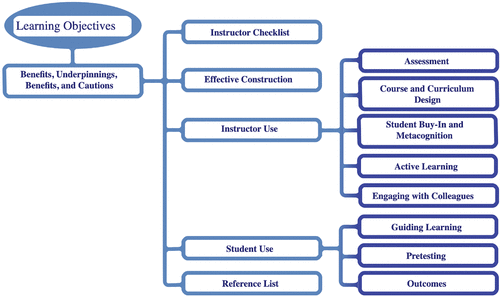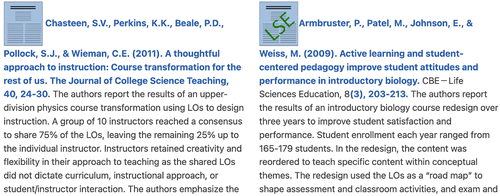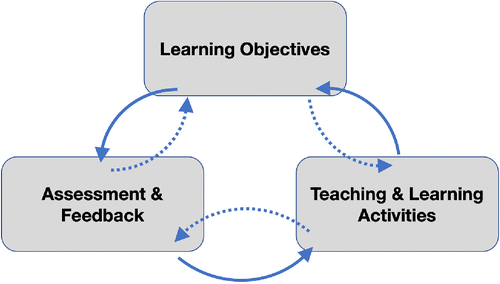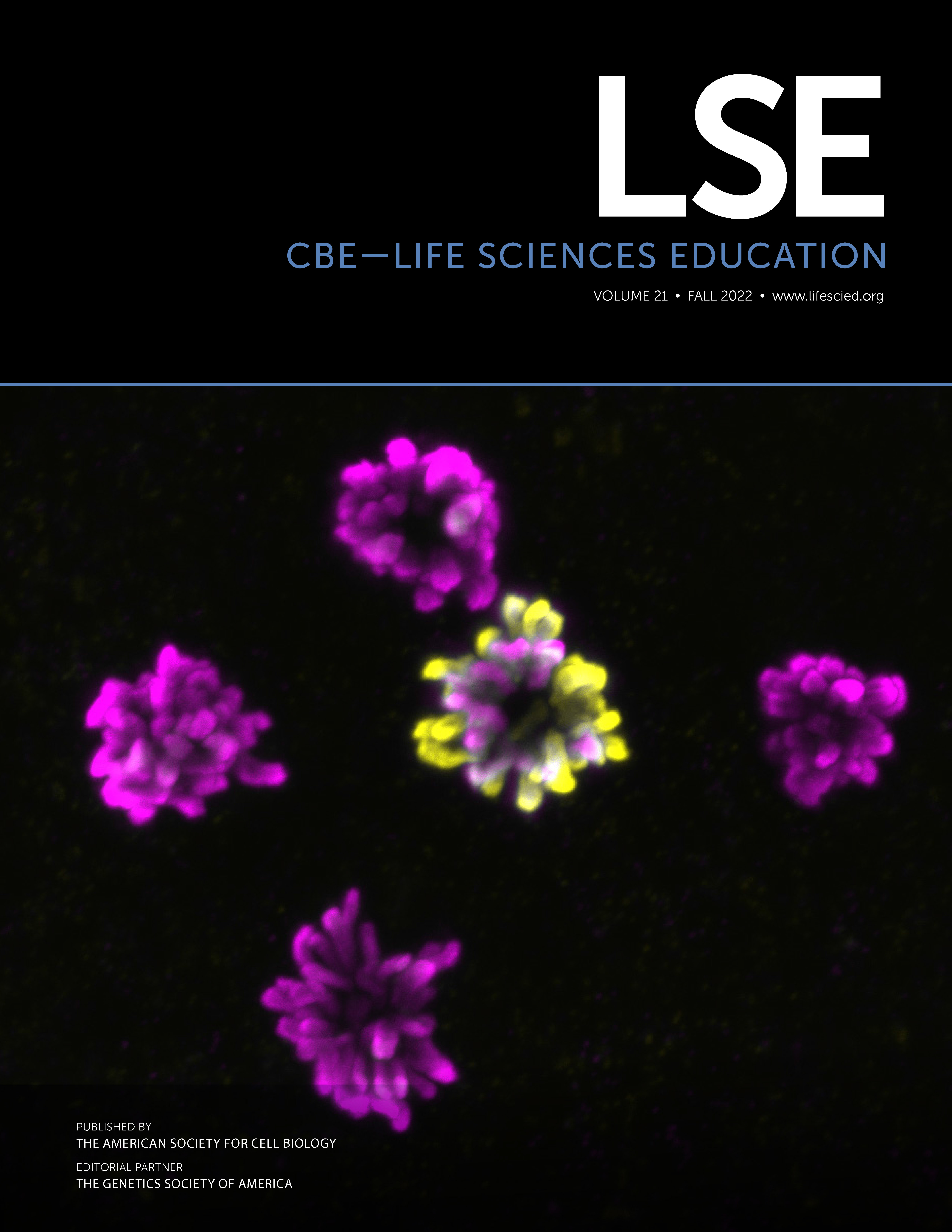Writing and Using Learning Objectives
Abstract
Learning objectives (LOs) are used to communicate the purpose of instruction. Done well, they convey the expectations that the instructor—and by extension, the academic field—has in terms of what students should know and be able to do after completing a course of study. As a result, they help students better understand course activities and increase student performance on assessments. LOs also serve as the foundation of course design, as they help structure classroom practices and define the focus of assessments. Understanding the research can improve and refine instructor and student use of LOs. This essay describes an online, evidence-based teaching guide published by CBE—Life Sciences Education (LSE) at http://lse.ascb.org/learning-objectives. The guide contains condensed summaries of key research findings organized by recommendations for writing and using LOs, summaries of and links to research articles and other resources, and actionable advice in the form of a checklist for instructors. In addition to describing key features of the guide, we also identify areas that warrant further empirical studies.
INTRODUCTION
Learning objectives (LOs) are statements that communicate the purpose of instruction to students, other instructors, and an academic field (Mager, 1997; Rodriguez and Albano, 2017). They form the basis for developing high-quality assessments for formative and summative purposes. Once LOs and assessments are established, instructional activities can help students master the material. Aligning LOs with assessments and instructional practice is the essence of backward course design (Fink, 2003).
Many terms in the literature describe statements about learning expectations. The terms “course objectives,” “course goals,” “learning objectives,” “learning outcomes,” and “learning goals” are often used interchangeably, creating confusion for instructors and students. To clarify and standardize usage, the term “objective” is defined as a declarative statement that identifies what students are expected to know and do. At the same time, “outcome” refers to the results measured at the end of a unit, course, or program. It is helpful to think of LOs as a tool instructors use for describing intended outcomes, regardless of the process for achieving the outcome (Mager, 1997). The term “goal” is less useful. Although it is often used to express more general expectations, there is no consistent usage in the literature.
In this guide, “learning objective” is defined as a statement that communicates the purpose of instruction using an action verb and describes the expected performance and conditions under which the performance should occur. Examples include:
At the end of this lesson, students should be able to compare the processes of diffusion, osmosis, and facilitated diffusion, and provide biological examples that illustrate each process.
At the end of this lesson, students should be able to predict the relative rates at which given ions and molecules will cross a plasma membrane in the absence of membrane protein and explain their reasoning.
In terms of content and complexity, LOs should scaffold professional practice, requirements for a program, and individual course goals by communicating the specific content areas and skills considered important by the academic field (Rodriguez and Albano, 2017). They also promote course articulation by supporting consistency when courses are taught by multiple instructors and furnishing valuable information about course alignment among institutions. As a result, LOs should serve as the basis of unit or module, course, and program design and can be declared in a nested hierarchy of levels. For clarity, we describe a hierarchy of LOs in Table 1.
| Type of LO | Scope and context | Description |
|---|---|---|
| Institutional | Broad, institution specific |
|
| Programmatic | Broad, program specific |
|
| Course level | Broad, course specific, and student centered |
|
| Instructional | Specific and descriptive, module or lesson specific, and student focused |
|
This article describes an evidence-based teaching guide that aggregates, summarizes, and provides actionable advice from research findings on LOs. It can be accessed at http://lse.ascb.org/learning-objectives. The guide has several features intended to help instructors: a landing page that indicates starting points (Figure 1), syntheses of observations from the literature, summaries of and links to selected papers (Figure 2), and an instructor checklist that details recommendations and points to consider. The focus of our guide is to provide recommendations based on the literature for instructors to use when creating, revising, and using instructional LOs in their courses. The Effective Construction section provides evidence-based guidelines for writing effective LOs. The Instructor Use section contains research summaries about using LOs as a foundational element for successful course design, summaries of the research that supports recommended practices for aligning LOs with assessment and classroom instruction, and direction from experts for engaging with colleagues in improving instructor practice with LOs. The Student Use section includes a discussion on how students use LOs and how instructor guidance can improve student use of LOs, along with evidence on the impact of LO use coupled with pretests, transparent teaching methods, and summaries of LO-driven student outcomes in terms of exam scores, depth of learning, and affect (e.g., perception of utility and self-regulated learning). Some of the questions and considerations that serve to organize the guide are highlighted in the following sections.

FIGURE 1. LO guide landing page, which provides readers with an overview of choice points.

FIGURE 2. Screenshots representing summaries of and links to selected papers.
WRITING EFFECTIVE INSTRUCTIONAL LEARNING OBJECTIVES
Writing LOs effectively is essential, as their wording should provide direction for developing instructional activities and guide the design of assessments. Effective LOs clearly communicate what students should know and be able to do and are written to be behavioral, measurable, and attainable (Rodriguez and Albano, 2017). It is particularly important that each LO is written with enough information to ensure that other knowledgeable individuals can use the LO to measure a learner’s success and arrive at the same conclusions (Mager, 1997). Clear, unambiguous wording encourages consistency across sections and optimizes student use of the stated LOs.
Effective LOs specify a visible performance—what students should be able to do with the content—and may also include conditions and the criteria for acceptable performance (Mager, 1997). When constructing an LO, one should use an action verb to describe what students are expected to know and be able to do with the disciplinary knowledge and skills (Figure 3). Bloom’s taxonomy of cognitive skills provides a useful framework for writing LOs that embody the intended complexity and the cognitive demands involved in mastering them (Bloom, 1956; Anderson and Krathwohl, 2001). Assessment items and course activities can then be aligned with LOs using the Blooming Biology Tool described by Crowe et al. (2008). However, LOs should not state the instructional method(s) planned to accomplish the objectives or be written so specifically as to be assessment tasks themselves (Mager, 1997).

FIGURE 3. Components of an LO.
Our Instructor Checklist provides specific recommendations for writing LOs, along with a link to examples of measurable action verbs associated with Bloom’s taxonomy.
COURSE DESIGN: ALIGNING LEARNING OBJECTIVES WITH ASSESSMENT AND CLASSROOM INSTRUCTION
Course designs and redesigns built around clear and measurable LOs result in measurable benefits to students (e.g., Armbruster et al., 2009, and other citations in the Course and Curriculum Design and Outcomes section of this guide). LOs are established as the initial step in backward design (McTighe and Wiggins, 2012). They provide a framework for instructors to 1) design assessments that furnish evidence on the degree of student mastery of knowledge and skills and 2) select teaching and learning activities that are aligned with objectives (Mager, 1997; Rodriguez and Albano, 2017). Figure 4 depicts depicts integrated course course design, emphasizing the dynamic and reciprocal associations among LOs, assessment, and teaching practice.

FIGURE 4. Components of integrated course design (after Fink, 2003).
Used in this way, LOs provide a structure for planning assessments and instruction while giving instructors the freedom to be creative and flexible (Mager, 1997; Reynolds and Kearns, 2017). In essence, LOs respond to the question: “If you don’t know where you’re going, how will you know which road to take and how do you know when you get there?” (Mager, 1997, p. 14). When assessments are created, each assessment item or task must be specifically associated with at least one LO and measure student learning progress on that LO. The performance and conditions components of each LO should guide the type of assessment developed (Mager, 1997). Data gathered from assessment results (feedback) can then inform future instruction. The Assessment section of our guide contains summaries of research reporting the results of aligning assessment with LOs and summaries of frameworks that associate assessment items with LOs.
The purpose of instruction is communicated to students most effectively when instructional activities are aligned with associated instructional and course-level LOs (e.g., Chasteen et al., 2011, and others within the Instructor Use section of this guide). The literature summarized in the Course and Curriculum Design section of the guide supports the hypothesis that student learning is strongly impacted by what instructors emphasize in the classroom. In the guide’s Student Buy-In and Metacognition section, we present strategies instructors have used to ensure that LOs are transparent and intentionally reinforced to students. When LOs are not reinforced in instruction, students may conclude that LOs are an administrative requirement rather than something developed for their benefit. The guide’s Instructor Checklist contains evidence-based suggestions for increasing student engagement through making LOs highly visible.
Using LOs as the foundation of course planning results in a more student-centered approach, shifting the focus from the content to be covered to the concepts and skills that the student should be able to demonstrate upon successfully completing the course (e.g., Reynolds and Kearns, 2017, and others within the Active Learning section of this guide). Instead of designing memorization-driven courses that are “a mile wide and an inch deep,” instructors can use LOs to focus a course on the key concepts and skills that prepare students for future success in the field. Group problem solving, discussions, and other class activities that allow students to practice and demonstrate the competencies articulated in LOs can be prioritized over lectures that strive to cover all of the content. The guide’s Active Learning section contains a summary of the literature on the use of LOs to develop activities that promote student engagement, provide opportunities for students to practice performance, and allow instructors to gather feedback on learning progress. The evidence-based teaching guides on Group Work and Peer Instruction provide additional evidence and resources to support these efforts.
ENGAGING WITH COLLEAGUES TO IMPROVE LEARNING OBJECTIVES
Momsen et al. (2010) examined Bloom’s level of assessment items and course goals from 50 faculty in 77 introductory biology courses for majors. The authors found that 93% of the assessment items were rated low-level Bloom’s, and 69% of the 250 course goals submitted were rated low-level Bloom’s (Momsen et al., 2010). A recent survey of 38 instructors of biology for nonmajors found similar results. Heil et al. (unpublished data) reported that 74% of the instructors surveyed write their own LOs, and 95% share their LOs with their students (Heil et al., unpublished data). The action verbs used in 66% of these LOs were low-level Bloom’s cognitive skills, assessing knowledge and comprehension (Heil et al., unpublished data). Further, an analysis of 1390 LOs from three best-selling biology textbooks for nonscience majors found that 89% were rated Bloom’s cognitive skill level 1 or level 2. Vision & Change competencies, as articulated in the BioSkills Guide (Clemmons et al., 2020), were only present in 17.7% of instructors’ LOs and 7% of the textbook LOs (Heil et al., unpublished data). These data suggest that, in introductory biology for both majors and nonmajors, most instructors emphasize lower-order cognitive skills that are not aligned with teaching frameworks.
Researchers have documented effective strategies to improve instructors’ writing and use of LOs. The guide’s Engaging with Colleagues section contains summaries demonstrating that instructor engagement with the scholarship of teaching and learning can improve through professional development in collaborative groups—instructors can benefit by engaging in a collegial community of practice as they implement changes in their teaching practices (e.g., Richlin and Cox, 2004, and others within the Engaging with Colleagues section of the guide). Collaboration among institutions can create common course-level LOs that promote horizontal and vertical course alignment, which can streamline articulation agreements and transfer pathways between institutions (Kiser et al., 2022). Departmental efforts to map LOs across program curricula can close gaps in programmatic efforts to convey field-expected criteria and develop student skills throughout a program (Ezell et al., 2019). The guide contains summaries of research-based recommendations that encourage departmental support for course redesign efforts (e.g., Pepper et al., 2012, and others within the Engaging with Colleagues section of the guide).
HOW DO LEARNING OBJECTIVES IMPACT STUDENTS?
When instructors publish well-written LOs aligned with classroom instruction and assessments, they establish clear goalposts for students (Mager, 1997). Using LOs to guide their studies, students should no longer have to ask “Do we have to know …?” or “Will this be on the test?” The Student Use section of the guide contains summaries of research on the impact of LOs from the student perspective.
USING LEARNING OBJECTIVES TO GUIDE STUDENT LEARNING
Researchers have shown that students support the use of LOs to design class activities and assessments. In the Guiding Learning section of the guide, we present evidence documenting how students use LOs and how instructors can train students to use them more effectively (Brooks et al., 2014, and other citations within this section of the guide). However, several questions remain about the impact of LOs on students. For example, using LOs may improve students’ ability to self-regulate, which in turn may be particularly helpful in supporting the success of underprepared students (Simon and Taylor, 2009; Osueke et al., 2018). But this hypothesis remains untested.
There is evidence that transparency in course design improves the academic confidence and retention of underserved students (Winkelmes et al., 2016), and LOs make course expectations transparent to students. LOs are also reported to help students organize their time and effort and give students, particularly those from traditionally underserved groups, a better idea of areas in which they need help (Minbiole, 2016). Additionally, LOs facilitate the construction of highly structured courses by providing scaffolding for assessment and classroom instruction. Highly structured course design has been demonstrated to improve all students’ academic performance. It significantly reduces achievement gaps (difference in final grades on a 4.0 scale) between disadvantaged and nondisadvantaged students (Haak et al., 2011). However, much more evidence is needed on how LOs impact underprepared and/or underresourced students:
Does the use of LOs lead to increased engagement with the content and/or instructor by underprepared and/or underserved students?
Does LO use have a disproportionate and positive impact on the ability of underprepared and/or underresourced students to self-direct their learning?
Is there a significant impact on underserved students’ academic performance and persistence with transparent LOs in place?
In general, how can instructors help students realize the benefits of well-written LOs? Research indicates that many students never receive instruction on using LOs (Osueke et al., 2018). However, when students receive explicit instruction on LO use, they benefit (Osueke et al., 2018). Examples include teaching students how to turn LOs into questions and how to answer and use those questions for self-assessment (Osueke et al., 2018). Using LOs for self-assessment allows students to take advantage of retrieval practice, a strategy that has a positive effect on learning and memory by helping students identify what they have and have not learned (Bjork and Bjork, 2011; Brame and Biel, 2015). Some students, however, may avoid assessment strategies that identify what they do not understand or know because they find difficulty uncomfortable (Orr and Foster, 2013; Dye and Stanton, 2017).
Brooks et al. (2014) reported that about one-third of students surveyed indicated that they had underestimated the depth of learning required to pass an assessment on the stated LOs. Further, students may have difficulty understanding the scope or expectations of stated LOs until after learning the content. Research on how instructors should train students to use LOs has been limited, and many of these open questions remain:
What are the best practices to help students use LOs in self-assessment strategies?
How can instructors motivate students to go outside their comfort zones for learning and use LOs in self-assessment strategies?
How can instructors help students better understand the performance, conditions, and criteria required by the LOs to demonstrate successful learning?
How might this differ for learners at different institutions, where academic preparedness and/or readiness levels may vary greatly?
CAPITALIZING ON THE PRETEST EFFECT
The guide’s Pretesting section contains research findings building on the pretesting effect reported by Little and Bjork (2011). Pretesting with questions based on LOs has been shown to better communicate course expectations to students, increase student motivation and morale by making learning progress more visible, and improve retention of information as measured by final test scores (Beckman, 2008; Sana et al., 2020). Operationalizing LOs as pretest questions may serve as an effective, evidence-based model for students to self-assess and prepare for assessment. The research supporting this strategy is very limited, however, prompting the following questions:
How broadly applicable—in terms of discipline and course setting—is the benefit of converting LOs to pretest questions?
Is the benefit of operationalizing LOs to create pretests sustained when converting higher-level Bloom’s LOs into pretest questions?
Does the practice of using LOs to create pretest questions narrow students’ focus such that the breadth/scope of their learning is overly limited/restricted? This is particularly concerning if students underestimate the depth of learning required by the stated LOs (Brooks et al., 2014).
Could this practice help instructors teach students to use LOs to self-assess with greater confidence and persistence?
STUDENT OUTCOMES
The guide concludes with research summaries regarding the specific benefits to students associated with the use of LOs. Specifically, 1) alignment of LOs and assessment items is associated with higher exam scores (e.g., Armbruster et al., 2009, and others within the Outcomes section of the guide); 2) exam items designed to measure student mastery of LOs can support higher-level Bloom’s cognitive skills (e.g., Armbruster et al., 2009, and others within the Outcomes section of the guide); and 3) students adjust their learning approach based on course design and have been shown to employ a deeper approach to learning in courses in which assessment and class instruction are aligned with LOs (Wang et al., 2013).
CHALLENGES IN MEASURING THE IMPACT OF LEARNING OBJECTIVES
It is difficult to find literature in which researchers measured the impact of LOs alone on student performance due to their almost-necessary conflation with approaches to assessment and classroom practices. We argue that measuring the impact of LOs independently of changes in classroom instruction or assessment would be inadvisable, considering the role that LOs play in integrated course design (Figure 4). Consistent with this view, the guide includes summaries of research findings on course redesigns that focus on creating or refining well-defined, well-written LOs; aligning assessment and classroom practice with the LOs; and evaluating student use and/or outcomes (Armbruster et al., 2009; Chasteen et al., 2011). We urge instructors to use LOs from this integrated perspective.
CONCLUSIONS
We encourage instructors to use LOs as the basis for course design, align LOs with assessment and instruction, and promote student success by sharing their LOs and providing practice with how best to use them. Instructor skill in using LOs is not static and can be improved and refined with collaborative professional development efforts. Our teaching guide ends with an Instructor Checklist of actions instructors can take to optimize their use of LOs (http://lse.ascb.org/learning-objectives/instructor-checklist).
ACKNOWLEDGMENTS
We thank Kristy Wilson for her guidance and support as consulting editor for this effort and Cynthia Brame and Adele Wolfson for their insightful feedback on this paper and the guide. This material is based upon work supported in part by the National Science Foundation under grant number DUE 201236 2. Any opinions, findings, conclusions, or recommendations expressed in this material are those of the authors. They do not necessarily reflect the views of the National Science Foundation.



